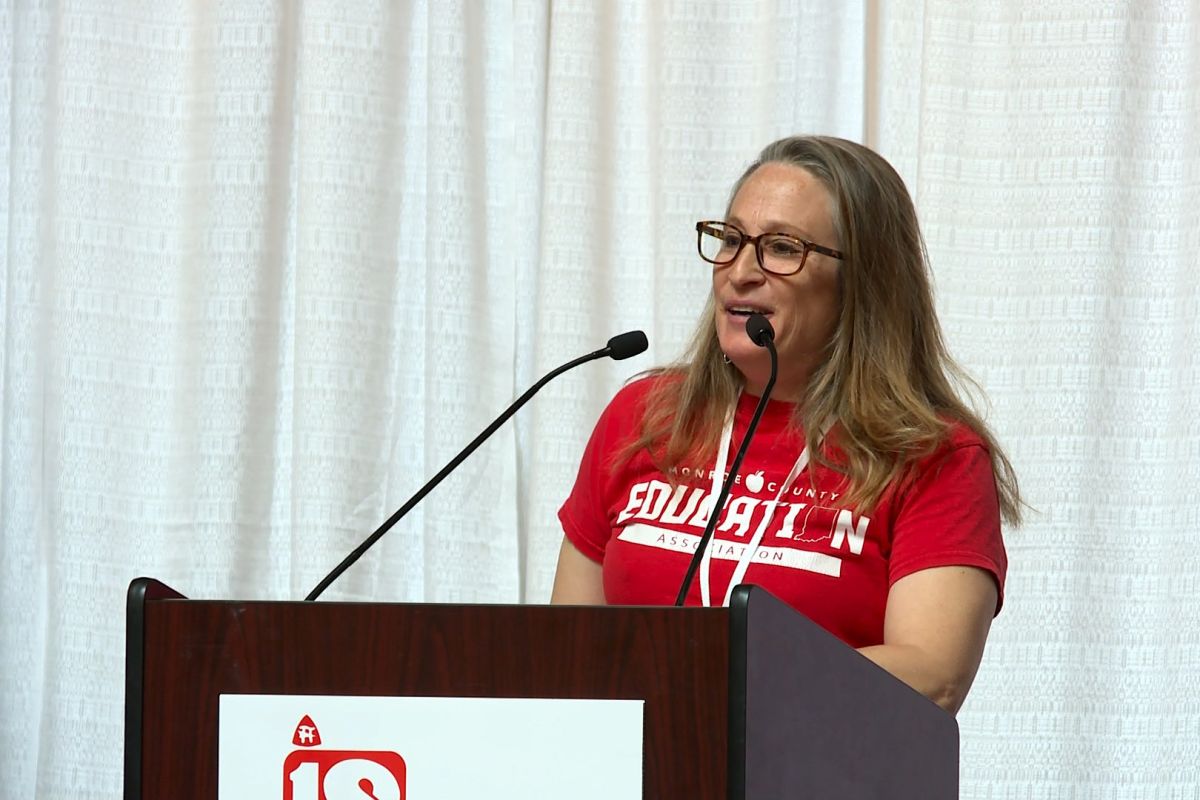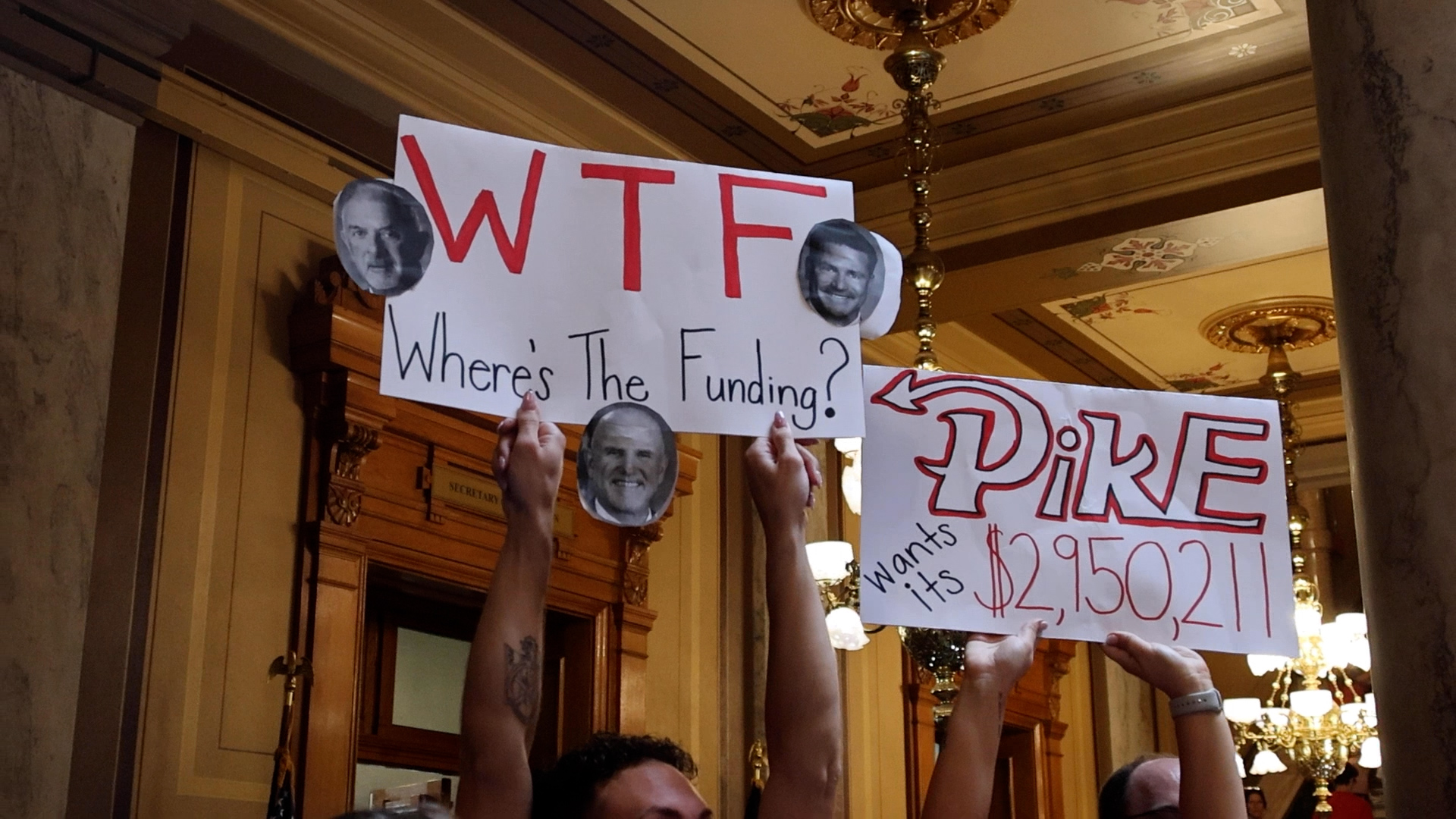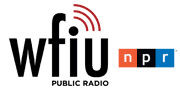
Jenny Noble-Kuchera, president of the Monroe County Education Association, spoke to the crowd at the Statehouse during the Indiana State Teachers Association's Day of Action on April 14. (Devan Ridgway, WTIU)
While Indiana’s new property tax plan will save most homeowners money, school districts are going to miss out on millions.
Worried about the state of public education, hundreds of Indiana State Teachers Association members, students and supporters rallied at the Indiana Statehouse April 14.
Jenny Noble-Kuchera, president of the Monroe County Education Association, spoke to the crowd at the Statehouse. She said the General Assembly is diverting funds from public schools — where 90 percent of Hoosier students get their education. Some schools may have to share their shrinking revenue with charter schools.
“We are taking our rage, we are taking our love, we are taking our prayers, and we are demanding that you politicians do what Hoosier unions and kids need,” Noble-Kuchera told the crowd. “Fund our public schools.”
Despite the rally, public criticism and intense debates in the General Assembly, Gov. Mike Braun signed the tax relief plan into law April 15. The relief plan is estimated to save about two-thirds of homeowners money.
Read more: Gov. Mike Braun signs 'historic' property tax relief bill into law, critics call it a 'lose-lose'
Changes begin in 2026, and through 2028, Indiana schools will miss out on more than $744 million because of the tax cuts.
Sen. Jeff Raatz (R-27), chair of the Senate education committee, said lawmakers are aware of concerns. Schools around the state will feel the impacts differently. Property tax revenue is usually steady and reliable income, he said, and some schools aren’t going to get what they expected.
“There's a lot of variables here, but we're absolutely cognizant that we want to make sure that districts have the ability to educate students,” Raatz said.

Raatz said public schools remain important.
“Whether it's a voucher school, whether it's a charter school, whether it's a traditional public school, we're talking about educating kids.” Raatz said. “We can argue about the dollars, and we should argue about the amount of dollars. It's always going to be a consideration and a problem, right?”
How much will MCCSC miss out on?
The Monroe County Community School Corporation was already trying to balance its budget by reducing spending.
MCCSC Superintendent Markay Winston says now, the corporation is going to miss out on millions of dollars it was expecting over the next few years. The numbers aren’t finalized yet, she said.
“The estimates that we've heard so far — anywhere from $14.7 million over the next three years to about $17.2 million,” Winston said. “Somewhere in there is the amount of money that we are anticipating not receiving going forward.”
Read more: 'Do less with less:' MCCSC anticipates cuts in staff in response to property tax cut bill
Winston said MCCSC students won’t bear the brunt of the cuts, and she doesn’t expect the quality of education to decrease.
“We're going to figure out, what does that new normal look like?” Winston said. “And today, I don't know what that new normal is going to be, but we are certainly committed to figuring that out.”
Winston and Noble-Kuchera said they are grateful that Monroe County taxpayers have committed to funding schools through referendums. Voters most recently passed a referendum in 2023 for early childhood education. But MCCSC may not get all of that revenue starting in 2028.
Public schools that lose 100 or more students to charter schools will have to share their revenue. More than two dozen school districts, including MCCSC, will be impacted. Phased over four years, the revenue would help charter schools pay for transportation, utilities and capital projects.
Read more: Charter schools could gain local tax dollars under new Indiana House plan
“We anticipate that we will not get all of the dollars that our community has committed to us having,” Winston said.
Noble-Kuchera said schools are also bracing for cuts to federal funding as the Trump Administration attempts to dismantle the Department of Education. Schools with low-income students and students with disabilities can usually count on Title I funding.
“Teachers are great, but we are not magicians,” Noble-Kuchera said.
What could happen without that money?
Though nothing is finalized, Winston said MCCSC may have to cut staff.
“I can't even begin to give you anything more specific, but staffing is the most significant expenditure that any school corporation has,” Winston said. “We would take everything under consideration. We would engage in conversations with our administration, our teachers, and figure out, how do we go forward?”
Listen: The MCCSC superintendent and school board president discuss their plans for the future
Winston said MCCSC leaders will have more information to share after the legislative session.
Noble-Kuchera said it’s possible students could lose extracurricular activities — places where students find where they fit socially and learn more outside of a classroom.

“Another possibility is that class sizes could increase,” Noble-Kuchera said. “We want to make sure that's equitable across the district, and our superintendent and their team is behind us in making sure that things are as equitable as possible.”
Indiana already has a teacher shortage. Teacher pay is another major issue, Noble-Kuchera said, and the union wants to make sure educators can afford to live and teach in Monroe County.
Read more: Here's how much Indiana teachers get paid. State lawmakers could bump it up
ISTA President Keith Gambill said at the Statehouse on April 15 the union is happy with some progress made in the legislative session, but some issues persist.
“The overall funding increase of 2 percent per year, totaling $870 million, does not even meet inflation” Gambill said. “It's not enough to address teacher shortages, student mental health needs or classroom resources. We are grateful for the movement in the right direction, but it is still not enough. Our students deserve bold investment, not the bare minimum.”
Isabella Vesperini contributed reporting to this story.
Aubrey is our higher education reporter and a Report For America corps member. Contact her at aubmwrig@iu.edu or follow her on X @aubreymwright.











